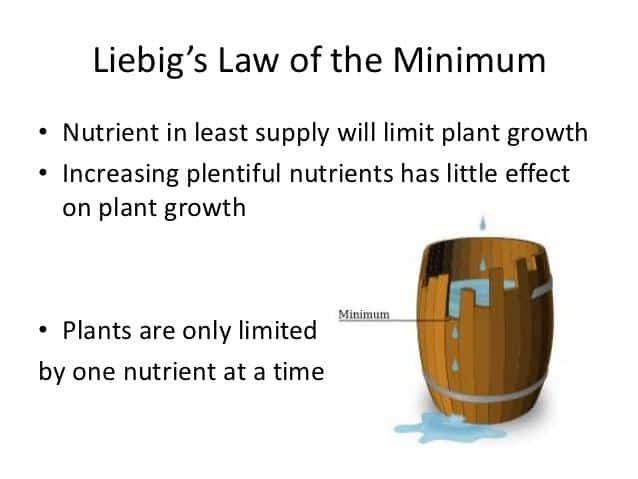Here’s a (sadly) recognisable story. A few years ago, I bought my first, “real” planted aquarium. Of course I immediately bought a large amount of fresh aquarium plants, probably worth about 100€. After a whole afternoon of planting, I was happy with the result. Satisfied, I plopped down in my seat, beer in hand. The tank looked nice and colourful and fresh. But after a few weeks, my new aquarium plants started growing worse and worse. My plants were dying one by one.
What was going on?
Murphy’s Law?
A classic example of Murphy’s Law? Where everything that can go wrong actually does go wrong? Well, if you don’t investigate the situation further, you might think so. Just bad luck… But it wasn’t. My plants were growing badly and I needed to know why.
Why your plants don’t grown: Liebig’s law of the minimum
Have you ever heard of Liebig’s law of the minmum? According to (Justus von) Liebig’s law the growth of your plants will stagnate as soon as there is one element missing from the nutrition of your aquarium plants. In other words, your aquarium plants grow poorly because one of the necessary nutrients is absent or insufficient.

How to know if your plants have a deficiency?
All well and good, but how do you know when something is wrong? In other words: how do you notice nutritional deficiencies in your aquarium plants? It’s not an exact science, of course, but a bit of observation helps. And a list of what to keep an eye on, of course. 🙂
What should you look out for?
| Symptom | Element | Cause? |
| Leaves of aquarium plants become yellow or red | N (nitrates) | deficiency |
| Holes in leaves & leaves come loose | P (phosphate) / CO2 | deficiency |
| Leaves develop yellow spots, but the vein remains green | Mg (magnesium) / Zn (zinc) | deficiency |
| Old leaves get yellow spots & new leaves yellow edges. | SO4 (sulphate) | deficiency |
| Leaves have yellow edges, misshapen plant growth | Ca (calcium) | deficiency |
| New leaves have a yellow colour | S (sulfur) | deficiency |
| New leaf growth is misshapen and “frizzy” | CO2 | deficiency |
| The tops of aquarium plants are white, the veins remain green | Fe (iron) | deficiency |
| The veins are intact, but the leaf dies in between | Mn (manganese) | deficiency |
| The leaf tips & edges are darker, blotchy | Cu (copper) / CO2 | deficiency |
| New cuttings & leaves die off | B (boron) / CO2 | deficiency |
| Aquarium plants do not grow or remain small, white spots on leaves | CO2 | deficiency |
Important note: the top table is based on research on “terrestrial plants” and not aquatic plants. So be critical, they do not all apply to aquatic plants.
The solution to aquarium plants not growing?
You could dose each element as soon as you see problems. But that’s rather tedious and besides, you won’t see these symptoms until it’s already too late. It is much easier to work preventively: start adding a slight surplus so the plants can never get a deficiency. You can dose according to the Estimative Index, for instance, but even easier is to dose my All-in-One. One bottle of All-in-One contains all the nutrients in one dose and in the right amount.
The only thing left for you to pay attention to is:









